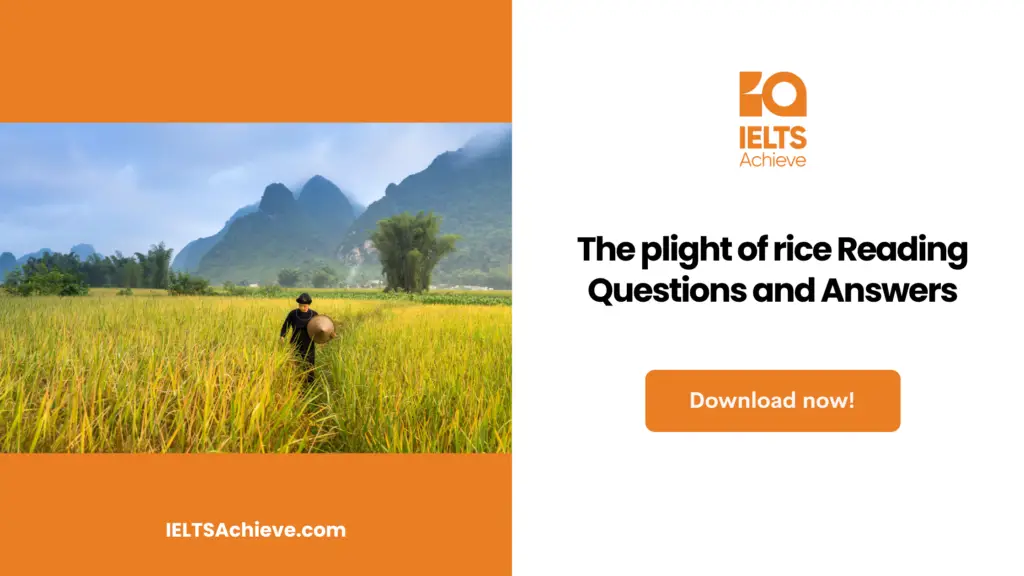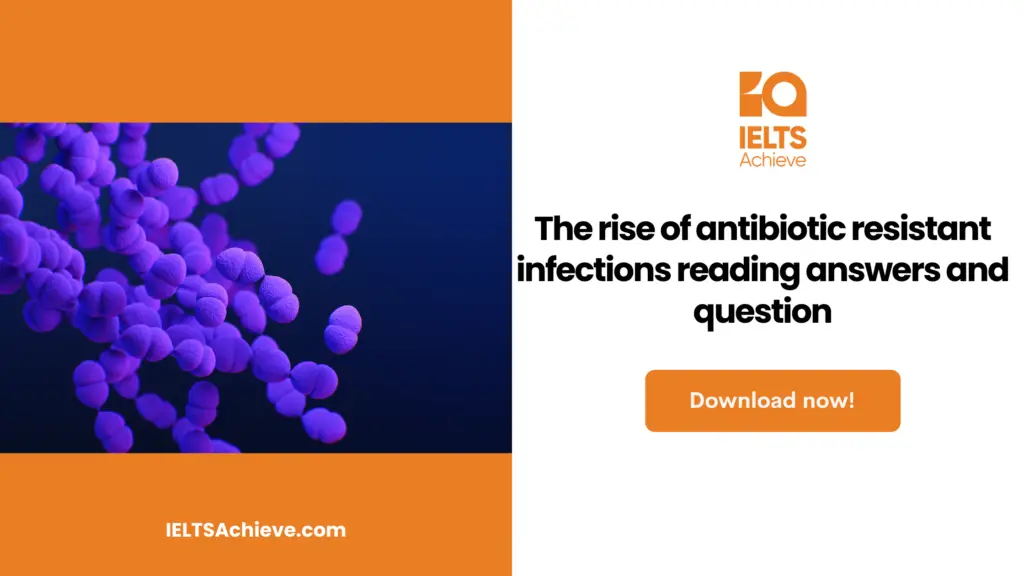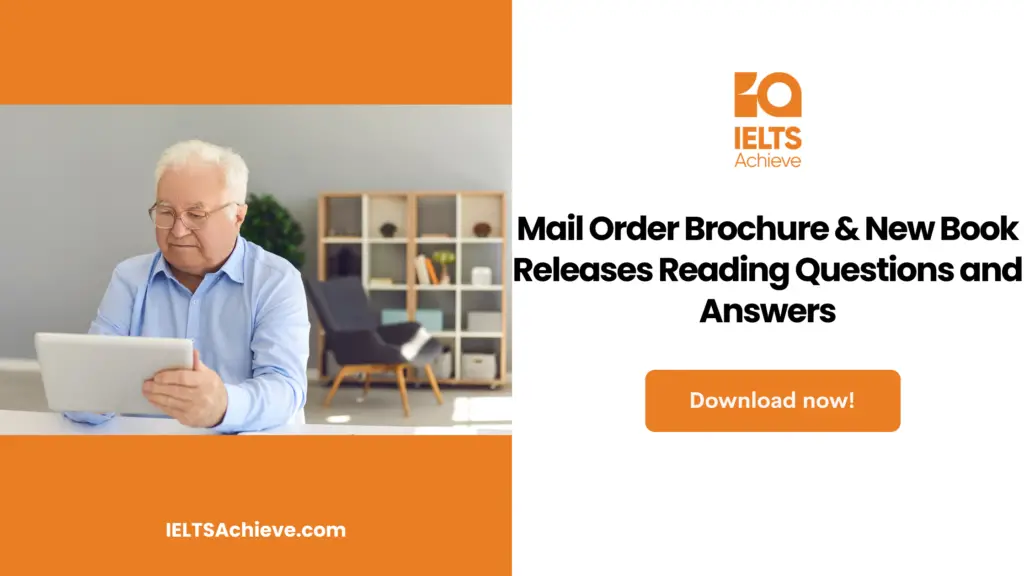The Blog post contains the following IELTS Reading Questions:
- IELTS Reading True/False/Not given
- IELTS Reading Multiple Choice Questions
- IELTS Reading Note Completion
Stay informed and prepared for success – Explore our comprehensive Reading Test Info page to get valuable insights, exam format details, and expert tips for mastering the IELTS Reading section.
IELTS reading passage – The plight of rice

The plight of rice
Rice is a tall grass with a drooping panicle that contains numerous edible grains and has been cultivated in China for more than 6,000 years. A staple throughout Asia and large parts of Africa, it is now grown in flooded paddy fields from sea level to high mountains and harvested three times a year. According to the Food and Health Organisation of the United Nations, around four billion people currently receive a fifth of their calories from rice.
Recently, Japan, South Korea, and Taiwan have slightly reduced rice consumption due to the adoption of more western diets, but almost all other countries have raised their consumption due to population increase. Yet, since 1984, there have been diminishing rice yields around the world.
From the 1950s to the early 1960s, rice production was also suffering: India was on the brink of famine, and China was already experiencing one. In the late 1950s, Norman Borlaug, an American plant pathologist, began advising Punjab State in northwestern India to grow a new semi-dwarf variety of wheat. This was so successful that, in 1962, a semi-dwarf variety of rice, called IR8, developed by the Philippine International Rice Research Institute (IRRI), was planted throughout Southeast Asia and India. This semi-dwarf variety heralded the Green Revolution, which saved the lives of millions of people by almost doubling rice yields: from 1.9 metric tons per hectare in 1950-64, to 3.5 metric tons in 1985-98.
IR8 survived because, as a semi-dwarf, it only grows to a moderate height, and it does not thin out, keel over, and drown like traditional varieties. Furthermore, its short thick stem is able to absorb chemical fertilizers, but, as stem growth is limited, the plant expends energy on producing a large panicle of heavy seeds, ensuring a greater crop.
However, even with a massive increase in rice production, semi-dwarf varieties managed to keep up with population growth for only ten years. In Africa, where rice consumption is rising by 20% annually, and where one-third of the population now depends on cereal, this is disturbing. At the current rate, within the next 20 years, rice will surpass maize as the major source of calories on that continent. Meantime, even in ideal circumstances, paddies worldwide are not producing what they once did, for reasons largely unknown to science. An average 0.8% fall in yields has been noted in rich rice-growing regions; in less ideal ones, flood, drought and salinity have meant yields have fallen drastically, sometimes up to 40%.
The sequencing of the rice genome took place in 2005, after which the IRRI developed genetically modified flood-resistant varieties of rice, called Sub 1, which produce up to four times more edible grain than non-modified strains. In 2010, a handful of farmers worldwide were planting IRRI Sub 1 rice; now, over five million are doing so. Currently, drought- and salt-resistant varieties are being trialed since most rice is grown in the great river basins of the Brahmaputra, the Irrawaddy, and the Mekong that are all drying up or becoming far saltier.
With global warming, many rice-growing regions are hotter than 20 years ago. Nearly all varieties of rice; including IR8, flower in the afternoon, but the anthers – little sacs that contain male pollen – wither and die in soaring temperatures. IRRI scientists have identified one variety of rice, known as Odisha, that flowers in the early morning and they are in the process of genetically modifying IR8 so it contains Odisha-flowering genes, although it may be some time before this is released.
While there is a clear need for more rice, many states and countries seem less keen to influence agricultural policy directly than they were in the past. Some believe rice demand will dip in wealthier places, as occurred in Japan, South Korea, and Taiwan; others consider it more prudent to devote resources to tackling obesity or to limiting intensive farming that is environmentally destructive.
Some experts say where there is state intervention it should take the form of reducing subsidies to rice farmers to stimulate production; others propose that small landholdings should be consolidated into more economically viable ones. There is no denying that land reform is pressing, but many governments shy away from it, fearing losses at the ballot box, all the while knowing that rural populations are heading for the city in droves anyway. And, as they do so, cities expand, eating up fertile land for food production.
One can only hope that the IRRI and other research institutions will spearhead half a dozen mini green revolutions, independently of uncommitted states.
Unlock your full potential in the IELTS Reading section – Visit our IELTS Reading Practice Question Answer page now!
Recommended Questions:
Renewable Energy IELTS Reading Question with Answer
Questions
Questions 1-5
- Do the following statements agree with the information given in Reading passage 1?
- In boxes 1-5 on your answer sheet, write:
- True if the statement agrees with the information.
- False if the statement agrees with the information.
- Not given if there is no information on this.
1. Rice is only grown at a low elevation.
2. Rice has been cultivated in Africa for 3,000 years.
3. Since 1984, rice yields have decreased due to infestations of pests.
4. Norman Borlaug believed Punjabi farmers should grow semi-dwarf rice.
5. The Green Revolution increased rice yields by around 100%.
Enhance your skills in identifying information as True, False, or Not Given. Click here to discover expert strategies and techniques for mastering this question type in the IELTS Reading section.
Questions 6-11
- Complete the notes below.
- Choose one word and/ or a number from the passage for each answer.
- Write your answers in 6-11 on your answer sheet.
| Traditional varieties of rice | Grow tall and 6………………, leading to collapse |
| IR8 Variety | Absorbs fertilizer in its short 7………… With a large panicle of heavy seeds, it produces a bigger 8…….. |
| Sub 1 Varieties | Are flood-resistantProduce up to 9……………….. times the amount of grain than non-modified varieties Now grown by over 10………………. farmers |
| Odisha variety | Flowers in the early 11………………., 50 its anthers remain intact and pollination can occur |
Boost your performance in Summary, Notes, Table, and Flowchart Completion tasks. Click here to explore our detailed guide and learn how to effectively complete summaries, notes, tables, and flowcharts in the IELTS Reading section.
Questions 12-13
- Choose the correct letter A,B,C, or D.
- Write the correct letter in boxes 12-13 on your answer sheet.
12 States are more interested in……..than stimulating rice production.
A increasing wheat production
B reducing farm subsidies
C confronting obesity
D consolidating land holdings
13…….disappearing as urbanization speeds up.
A Intensive farming is
B Fertile land is
C Clean water is
D Agricultural institutes are
Ready to improve your performance in Multiple Choice Questions (MCQs)? Click here to access our comprehensive guide on how to tackle MCQs effectively in the IELTS Reading section.
Unlock your full potential in the IELTS Reading section – Visit our IELTS Reading Practice Question Answer page now!
Recommended Questions:
Renewable Energy IELTS Reading Question with Answer
Answers for the plight of rice
1. Answer: False
2. Answer: Not given
3. Answer: Not given
4. Answer: False
5. Answer: True
6. Answer: Thin
7. Answer: Stem
8. Answer: Crop
9. Answer: 4/four
10. Answer: 5/five million
11. Answer: Morning
12. Answer: C
13. Answer: B

We hope you found this post useful in helping you to study for the IELTS Test. If you have any questions please let us know in the comments below or on the Facebook page.
The best way to keep up to date with posts like this is to like us on Facebook, then follow us on Instagram and Pinterest. If you need help preparing for the IELTS Test, join the IELTS Achieve Academy and see how we can assist you to achieve your desired band score. We offer an essay correction service, mock exams and online courses.

